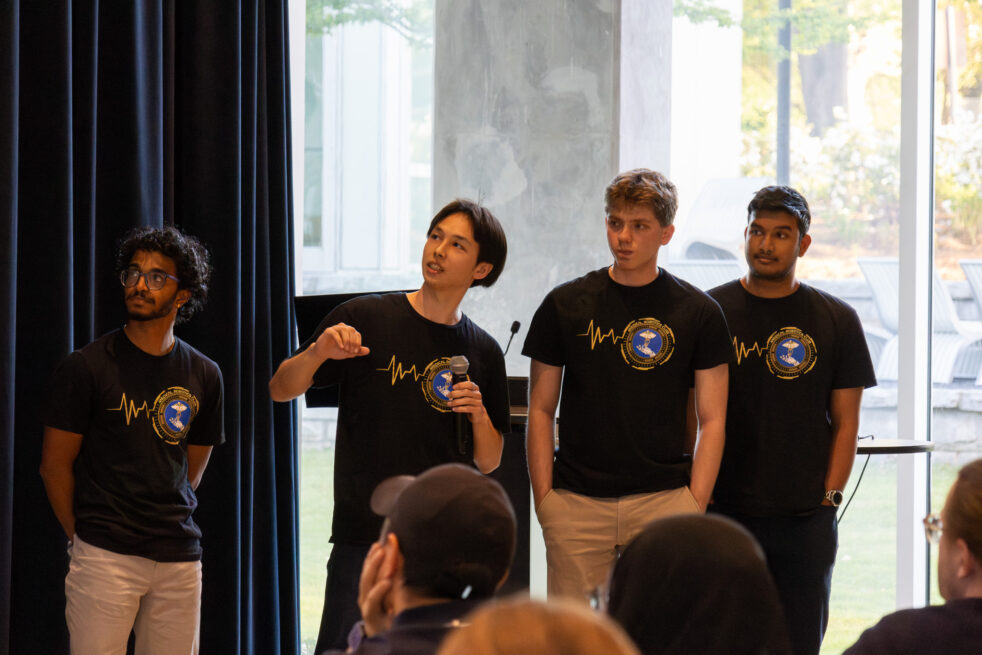GT Medical Robotics Club held its spring gala at 6 p.m. on April 15, 2025 for members to present their projects and showcase their skills in programming, designing and machine development.
Medical Robotics is an organization with a mission to “design robots that save lives,” with over three different teams, each dedicated to developing a prototype to solve a major medical issue. From low-cost, 3D-printed prosthetics to commercial devices for wheelchair users, Medical Robotics ensures that each active member learns how to design using computer-aided design (CAD) software and how to utilize the various maker spaces on campus.
Medical Robotics has a variety of teams that explore the different fields of medical prosthetics. Most recently added is the “Robotics 101” section, designed to help those with no programming experience learn the basics of machining, circuitry and using microcontrollers.
The Technique spoke with BuzzBots on ElectroVerity, a hot-pink stress detection device that makes use of red, yellow and green LEDs to depict a person’s stress levels.
“We initially came to Robo 101 not knowing much in terms of technical skills, so we built a lot in…CAD…[we learned] how to 3D print. Going to a maker space and actually being able to use everything after their official hours…we had the freedom to explore how to laser cut stuff, or how to use different sizes,” said Kristina Siju, first-year BMED, on designing the pink box fixed with sensors meant to track the sweat glands located on the fingertips.
Siju, alongside group members Katherine Meeks, first-year ME, and Sara Asadi, second-year BMED, were first to present their project at the banquet, piquingthe interests of former GT alumni, now representing the company Stryker who later visited the BuzzBots table and tested their own stress levels on what was originally a lie detector.
“There was nothing that was stressing us out enough when we originally had it as a lie detector…We realized that it was just a better indicator of just how stressed you were in general than if you were lying,” Meeks said.
Before the banquet took a brief recess for refreshments, networking and troubleshooting, another Robotics 101 subteam presented their device: a robotic arm designed to putt a ball around a golf course.
Team CABG — an acronym formed from the initials of each team member, pronounced “cabbage” — presented a robotic arm controlled by a motherboard equipped with handles that allowed the golf club to move in all four directions, as well as radially. The team included first-year BMED students Ashley Diaz-Duenas, Camila Gutierrez Reyes, and Joy Li, along with third-year BMED student Olubande Taiwo. All were new to Medical Robotics and had no prior programming experience.
“Coming into this, some of us had very limited experience with Arduinos, cadding and such, so we had to learn along the way…We knew we had to do something simple…[so] we [designed] the parts in order to connect all the Arduinos, in order to make them move together. Some setbacks we had were initially the measurements for the robot, [but] we created a platform in order to keep that robot stable,” said Gutierrez Reyes on the process of developing the robot arm.
Medical Robotics takes care to properly ensure students are set up for success with three-hour weekly meetings, as well as upperclassmen project managers for each team to assist them with programming and configuring machine learning. Teams are also encouraged to reference other projects, research articles, and browse online for inspiration and extra help with the design process.
Along with each presentation, each group discussed future questions they wanted answers to as well as potential applications to the medical field.
“Our inspiration for the robotic arm was just like intermediate robot projects that we looked up online…It’s cool to see that like this [the robot arm] would be the most base level of things that would come to fruition if we went further into medical products,” said Taiwo, with Li adding their circuit diagram was modeled after circuits they found while researching.
The banquet continued with Teams Gaitway, Limbo, and Industry — teams of more experienced Medical Robotics members —showcasing their own devices.
Team Gaitway wowed the audience with their mission to create a low-cost prosthetic via 3D printing. Team Gaitway worked with below-knee amputees to design their product with future goals of making their prosthetic fit within a shoe, rather than standing bare on solid ground as the current prototype does.
Team Limbo presented their functional mechanical hand design, which utilized haptic feedback to restore the sense of touch. They tested their device using the popular Google Dino Run game and collected data with each spacebar press. Lastly, Team Industry wrapped up the presentation with a brief overview of their mission to help members develop industry skills through independent projects.
The Spring 2025 Banquet was an intriguing event that demonstrated GT Medical Robotics is composed of talented undergraduates dedicated to solving real-world problems with student-made solutions. Open to all majors, any year with any level of experience, Medical Robotics (@gtmedicalrobotics) strives to grow its organization with more creative minds interested in serving the medical field with technological devices.
